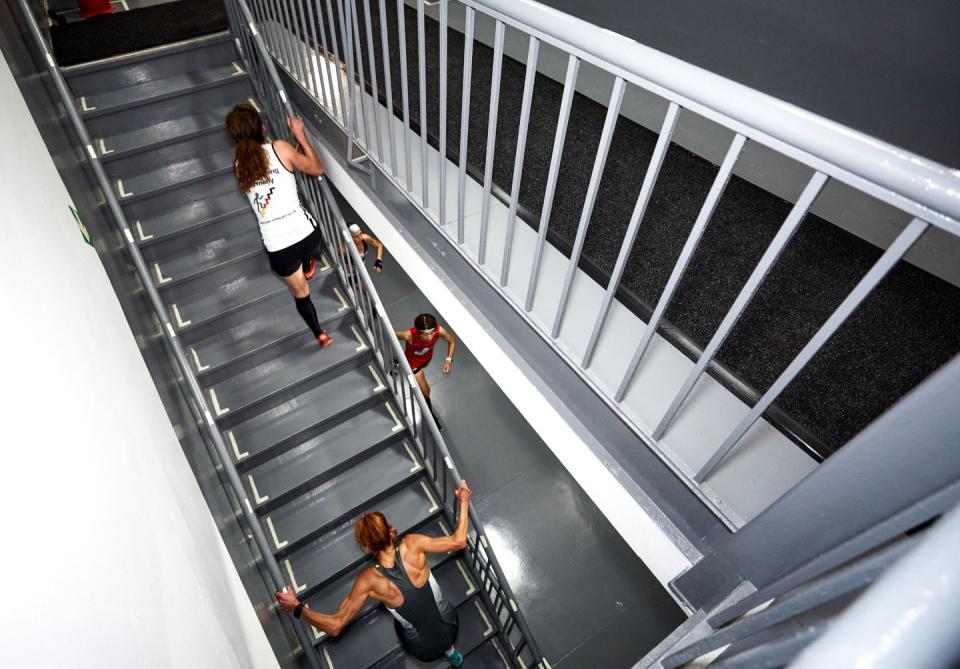'I trained to run up 86 flights of stairs, here are my results + 8 things it taught me'

Fitness challenges are great for many reasons – they keep you motivated in training, teach you new things about your body and mind and are just fun to do. After running the London marathon in April I wanted a new one – and signed up for the annual Empire State Building Run Up event earlier this month, running up 86 flights of stairs to the top of the fourth tallest building in New York.
What I learned about my fitness surprised me, from how quickly I got fit, to the multitude of health benefits that climbing stairs can provide. Here are the eight lessons I learned about the benefits of stair climbing, which can easily be incorporated into your daily life – no fancy kit required.
1.Taking the stairs is a stealthy way to get fit

I didn’t take my training as seriously as I perhaps should have – I just made it a rule to run up a flight of stairs whenever I saw one – and yet, I noticed my fitness improve quickly.
My experience is backed up by researchers at the University of Birmingham who found that in the 52 previously sedentary women they recruited to do two 'bouts' of stair climbing each day over eight weeks (the participants set their own amounts) all improved aerobic fitness, reduced cholesterol, increased leg strength and improved cardiovascular health.
The results were confirmed in a separate study published last month in the journal Atherosclerosis, which found that climbing five flights of stairs every day may reduce the risk of cardiovascular diseases such as stroke, blood clots, and heart attacks by as much as 20%.
2. You do need to fuel up first

To get the most out of stair climbing workouts, you do need to fuel your exercise session properly so you can push yourself. 'We run on carbs,' Stephanie Nelson, Resident Dietician at MyFitnessPal says. 'Your body breaks them down quickly and uses them for energy. For 30-60 minutes of cardio aim for a 30-60grams of carbs about one to two hours before exercise, which can be something like a bowl of porridge or a large banana.'
Her advice on amounts of carbohydrates are backed up by a study published in the journal Sports Medicine in 2014, and build on a previous study, which showed how endurance athletes lasted longer (and so worked harder) after a pre-workout dose of carbs.
I used the new Eat to Compete six-day plan recently released by MyFitnessPal to help me structure my nutrition before the event: I found the tips, such as how much water to take on and when (around 450ml of water at least two-three hours before working out and another 225ml around 30 minutes beforehand), particularly helpful.
3. Stair climbing is more effective than a jog

The reason taking the stairs is so much better than a steady jog, is because it gets your heart rate up faster, according to Anthony Fletcher, biomechanics coach and co-founder of the running app Onetrack.
'If you sprint for 10 seconds, your heart rate won’t actually go that high, but if you run up a set of stairs for 30 seconds your heart rate has time to react and reach higher values,' he says.
Even if you take it slowly, it’s still better than a jog. 'Because your muscle contractions are more concentric, meaning they shorten under tension as they push the floor away, they automatically burn more energy than eccentric contractions, when the muscles lengthening under tension as the body weight descends to the floor, such as when you’re running,' Fletcher explains. Meaning even plodding along will make you feel the burn.
4. Going down stairs might have more benefits than climbing them

My challenge was up to the top of the Empire State Building - mercifully I was allowed to take the lift down – but actually, going down again might have given me even more benefits.
A 2021 Chinese study found that those who were assigned descending stairs, rather than ascending, lost more abdominal fat. 'Running down hills (and similarly stairs) increases the amount of eccentric muscle work more than running on the flat and therefore has different effects on the body compared to going up,' Fletcher explains. Who knew?!
5. You can stair climb without a gym membership
Unlike lots of fitness trends, you don’t need a fancy bit of kit or even a gym membership. The University of Birmingham researchers, who split their group into those who did stair climbing at the gym and those who just did it at home, concluded that 'home-based climbing was at least as effective as an equivalent gym-based protocol.' Winning.
6. Climbing stairs is kind on the joints
For those who swerve running because they’re worried about their knees, climbing stairs is kinder on your knees and hips, since your foot never goes all the way down to the floor, meaning it creates a softer impact.
'Your body is not falling to the floor and there is no landing to be absorbed,' Fletcher says. 'This means that this type of activity might not take long to recover from and therefore we can either push a little harder or do it more regularly.'
7. It’s easier than it looks
It was a tough challenge, and by the end of the 86 flights I could feel my heart racing, but it wasn’t as hard as I thought; my chip time was 19 minutes 50 seconds, and it felt like an intense 5k race. In fact, it has encouraged me to add in stairs into my workout more often – it’s a great warm-up pre a strength session, and even just running up and down the stairs at home makes me feel like I’ve done a mini workout.
You Might Also Like


